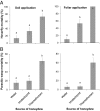Neonicotinoids in excretion product of phloem-feeding insects kill beneficial insects
- PMID: 31383752
- PMCID: PMC6708310
- DOI: 10.1073/pnas.1904298116
Neonicotinoids in excretion product of phloem-feeding insects kill beneficial insects
Abstract
Pest control in agriculture is mainly based on the application of insecticides, which may impact nontarget beneficial organisms leading to undesirable ecological effects. Neonicotinoids are among the most widely used insecticides. However, they have important negative side effects, especially for pollinators and other beneficial insects feeding on nectar. Here, we identify a more accessible exposure route: Neonicotinoids reach and kill beneficial insects that feed on the most abundant carbohydrate source for insects in agroecosystems, honeydew. Honeydew is the excretion product of phloem-feeding hemipteran insects such as aphids, mealybugs, whiteflies, and psyllids. We allowed parasitic wasps and pollinating hoverflies to feed on honeydew from hemipterans feeding on trees treated with thiamethoxam or imidacloprid, the most commonly used neonicotinoids. LC-MS/MS analyses demonstrated that both neonicotinoids were present in honeydew. Honeydew with thiamethoxam was highly toxic to both species of beneficial insects, and honeydew with imidacloprid was moderately toxic to hoverflies. Collectively, our data provide strong evidence for honeydew as a route of insecticide exposure that may cause acute or chronic deleterious effects on nontarget organisms. This route should be considered in future environmental risk assessments of neonicotinoid applications.
Keywords: biological control agents; environmental risk assessment; honeydew; pollinators; thiamethoxam.
Copyright © 2019 the Author(s). Published by PNAS.
Conflict of interest statement
The authors declare no conflict of interest.
Figures



Similar articles
-
Insecticide-contaminated honeydew: risks for beneficial insects.Biol Rev Camb Philos Soc. 2022 Apr;97(2):664-678. doi: 10.1111/brv.12817. Epub 2021 Nov 21. Biol Rev Camb Philos Soc. 2022. PMID: 34802185 Free PMC article. Review.
-
IPM-recommended insecticides harm beneficial insects through contaminated honeydew.Environ Pollut. 2020 Dec;267:115581. doi: 10.1016/j.envpol.2020.115581. Epub 2020 Sep 8. Environ Pollut. 2020. PMID: 33254691
-
Neonicotinoids from coated seeds toxic for honeydew-feeding biological control agents.Environ Pollut. 2021 Nov 15;289:117813. doi: 10.1016/j.envpol.2021.117813. Epub 2021 Jul 19. Environ Pollut. 2021. PMID: 34332171
-
Whiteflies can excrete insecticide-tainted honeydew on tomatoes.Environ Pollut. 2023 Nov 15;337:122527. doi: 10.1016/j.envpol.2023.122527. Epub 2023 Sep 10. Environ Pollut. 2023. PMID: 37699451
-
Neonicotinoids: molecular mechanisms of action, insights into resistance and impact on pollinators.Curr Opin Insect Sci. 2018 Dec;30:86-92. doi: 10.1016/j.cois.2018.09.009. Epub 2018 Sep 27. Curr Opin Insect Sci. 2018. PMID: 30553491 Review.
Cited by
-
Sesame as an Alternative Host Plant to Establish and Retain Predatory Mirids in Open-Field Tomatoes.Plants (Basel). 2022 Oct 20;11(20):2779. doi: 10.3390/plants11202779. Plants (Basel). 2022. PMID: 36297803 Free PMC article.
-
RNAi efficacy is enhanced by chronic dsRNA feeding in pollen beetle.Commun Biol. 2021 Apr 6;4(1):444. doi: 10.1038/s42003-021-01975-9. Commun Biol. 2021. PMID: 33824392 Free PMC article.
-
SLI1 confers broad-spectrum resistance to phloem-feeding insects.Plant Cell Environ. 2021 Aug;44(8):2765-2776. doi: 10.1111/pce.14064. Epub 2021 May 5. Plant Cell Environ. 2021. PMID: 33837973 Free PMC article.
-
Design of Novel Membranes for the Efficient Separation of Bee Alarm Pheromones in Portable Membrane Inlet Mass Spectrometric Systems.Int J Mol Sci. 2024 Aug 7;25(16):8599. doi: 10.3390/ijms25168599. Int J Mol Sci. 2024. PMID: 39201286 Free PMC article.
-
Evaluation of Selected Plant Essential Oils for Aphid Pest Control in Integrated Pest Management.Insects. 2025 Mar 27;16(4):353. doi: 10.3390/insects16040353. Insects. 2025. PMID: 40332836 Free PMC article.
References
-
- Goulson D., Lye G. C., Darvill B., Decline and conservation of bumble bees. Annu. Rev. Entomol. 53, 191–208 (2008). - PubMed
-
- Potts S. G., et al. , Global pollinator declines: Trends, impacts and drivers. Trends Ecol. Evol. 25, 345–353 (2010). - PubMed
-
- Ollerton J., Erenler H., Edwards M., Crockett R., Pollinator declines. Extinctions of aculeate pollinators in Britain and the role of large-scale agricultural changes. Science 346, 1360–1362 (2014). - PubMed
-
- Thomas J. A., et al. , Comparative losses of British butterflies, birds, and plants and the global extinction crisis. Science 303, 1879–1881 (2004). - PubMed
Publication types
MeSH terms
Substances
LinkOut - more resources
Full Text Sources

